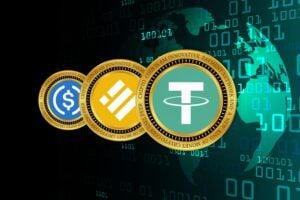Prediction markets are not a new idea. But what happens when you put them on the blockchain, combine them with cryptocurrencies, and give swarm intelligence the necessary trust? That’s exactly what Polymarket does – a decentralized platform that has been setting new standards in event speculation since its founding in 2020. Whether political elections, interest rates, climate change or sports tournaments – people from all over the world speculate on Polymarket on the outcome of real-world events. But what is behind the hype?
What is Polymarket – and why is it Different?
Polymarket is a so-called prediction market – which means: users buy shares in the outcome of future events. These shares reflect probabilities. If you are right, you get 1 USDC per share at the end – if you are wrong, the stake is lost. What sounds like betting is in reality a collective opinion exchange – and it is not that inaccurate: studies show that swarm intelligence often makes more accurate predictions than individuals or expert panels.
What makes Polymarket special: the platform runs decentrally on the Polygon blockchain, all processes are open and transparent, the stakes are transparent – manipulation is hardly possible. Users only need an Ethereum-compatible wallet and the stablecoin USDC to participate.
How Does Polymarket Work in Practice?
Anyone who uses Polymarket selects from a list of active events – for example: “Will the Fed cut interest rates by July 2025?” or “Will Trump be re-elected in 2024?”. For each question, there are two or more possible answers, which are given a dynamic price in USDC. This price moves according to demand and reflects the collective assessment of the market – similar to stock prices. The more people believe in a certain outcome and invest accordingly, the higher its price rises.
The pricing is done via an automatic market maker (AMM), which guarantees constant liquidity – even without a classic counterparty. After the event occurs, a reliable data provider (“oracle”) is used to confirm the actual result. The payout is then made automatically to the correct predictions.
Why is Polymarket so Successful?
1. The Appeal of Swarm Intelligence
People have always bet on the course of events. But Polymarket uses this intuition not for entertainment, but to aggregate collective knowledge. Anyone who invests there has usually researched, weighed arguments or is part of a community with a high level of information. This creates a knowledge exchange, the probabilities of which are often surprisingly accurate – even more accurate than many opinion polls, as the US elections in 2024 have shown.
2. Blockchain Creates Trust
Traditional betting providers require trust in their systems – Polymarket decentralizes this trust. Every trade, every payout and every market is documented on the blockchain and can be verified. The decision as to which result is “true” is also not arbitrary, but is based on verified oracles, such as from TheGraph or UMA. This strengthens trust in the integrity of the system.
3. Large Variety of Topics Meets Real Money
What distinguishes Polymarket from many platforms: it’s not just about entertainment. Political, economic and social developments are mapped here – sometimes with billions in volume. This is a real added value for traders, analysts and crypto enthusiasts: they can test their assessments – and profit from it if successful.
Who is behind Polymarket?
The platform was founded in 2020 by New York entrepreneur Shayne Coplan. He was supported by renowned investors such as Polychain Capital, Nascent and Ethereum co-founder Vitalik Buterin. The goal from the beginning was to create a place where opinions become measurable, transparent and tradable – a concept that has now become established.
Controversy and Criticism: Everything Decentralized?
Of course, Polymarket is not immune to criticism. In 2022, after an investigation by the US Commodity Futures Trading Commission (CFTC), the company had to pay a fine of 1.4 million US dollars and severely restrict access for US citizens. The reason: some markets were classified as unauthorized financial bets.
Discussions about market manipulation also arose – especially when large sums are suddenly placed on unlikely results. However, there has been no evidence of systematic manipulation to date, and Polymarket is continuously working on transparency measures.
Where Does Polymarket Stand Today?
With a previous trading volume of over 4 billion US dollars (as of June 2025), Polymarket is one of the most successful applications in the field of decentralized prediction markets worldwide. The platform is growing not only in volume, but also in social relevance – it is increasingly being cited by the media, used by analysts and taken seriously by observers.
Whether it’s election outcomes, economic decisions or global trends – the aggregated market prices of Polymarket are now considered a valuable indicator of real expectations.
Now take a look at the platform
Looking to the Future: where is the Journey Going?
The potential of Polymarket is enormous. In a time when classic information channels are struggling with bias, manipulation or inaccuracy, an open prediction market offers an alternative data source – democratic, decentralized, data-driven.
In addition, such markets could also be used in the future for corporate decisions, research projects or NGO projects: as a tool for collective risk assessment. Some startups and universities are already experimenting with internal Polymarket instances – for example, to assess project successes or social trends.
What does it take? Further regulatory clarity, a stable infrastructure – and above all: trust in collective judgment.
Conclusion: Polymarket as a Mirror of World Opinion
Polymarket is much more than a crypto betting platform. It is a mirror of what people around the world think, believe – and are willing to back up with real money. In a digital world full of opinions, misinformation and an abundance of data, Polymarket delivers something rare: a focused, dynamic and measurable assessment of reality.
Polymarket is an exciting example of the power of decentralization – and proof of how blockchain can change social processes far beyond coins and tokens.



